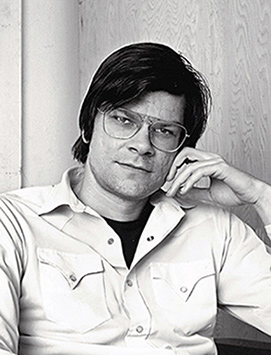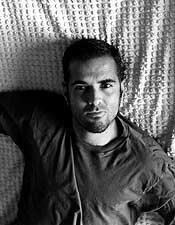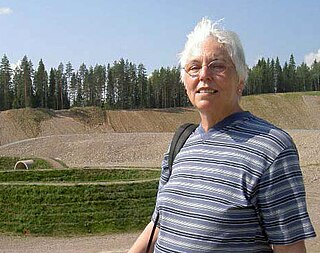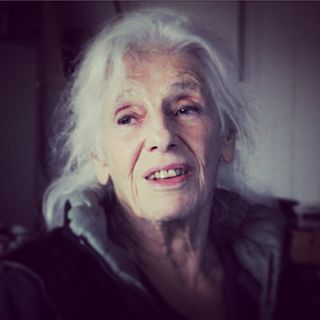
Robert Smithson was an American artist known for sculpture and land art who often used drawing and photography in relation to the spatial arts. His work has been internationally exhibited in galleries and museums and is held in public collections. He was one of the founders of the land art movement whose best known work is the Spiral Jetty (1970).

Land art, variously known as Earth art, environmental art, and Earthworks, is an art movement that emerged in the 1960s and 1970s, largely associated with Great Britain and the United States but that also includes examples from many countries. As a trend, "land art" expanded boundaries of art by the materials used and the siting of the works. The materials used were often the materials of the Earth, including the soil, rocks, vegetation, and water found on-site, and the sites of the works were often distant from population centers. Though sometimes fairly inaccessible, photo documentation was commonly brought back to the urban art gallery.

Félix González-Torres or Felix Gonzalez-Torres was a Cuban-born American visual artist. He lived and worked primarily in New York City between 1979 and 1995 after attending university in Puerto Rico. González-Torres’s practice incorporates a minimalist visual vocabulary and certain artworks that are composed of everyday materials such as strings of light bulbs, paired wall clocks, stacks of paper, and individually wrapped candies. González-Torres is known for having made significant contributions to the field of conceptual art in the 1980s and 1990s. His practice continues to influence and be influenced by present-day cultural discourses. González-Torres died in Miami in 1996 from AIDS-related illness.
Paul Jenkins was an American abstract expressionist painter.

Sam Gilliam was an American abstract painter and sculptor. Born in Mississippi and raised in Kentucky, Gilliam spent his entire adult life in Washington, D.C., eventually being described as the "dean" of the city's arts community. Originally associated with the Washington Color School, a group of Washington-area artists that developed a form of abstract art from color field painting in the 1950s and 1960s, Gilliam began to move beyond the movement's core aesthetics of flat fields of color when he introduced sculptural elements to his paintings. His work has also been described as lyrical abstraction.

Nancy Holt was an American artist most known for her public sculpture, installation art, concrete poetry, and land art. Throughout her career, Holt also produced works in other media, including film and photography. Since 2018, her legacy has been cared for by Holt/Smithson Foundation.

Josephine Gail Baer is an American painter associated with minimalist art. She began exhibiting her work at the Fischbach Gallery, New York, and other venues for contemporary art in the mid-1960s. In the mid-1970s, she turned away from non-objective painting. Since then, Baer has fused images, symbols, words, and phrases in a non-narrative manner, a mode of expression she once termed "radical figuration." She lives and works in Amsterdam, Netherlands.

De Wain Valentine was an American minimalist sculptor who was born in Fort Collins, Colorado. Often associated with the Light and Space movement in the 1960s, he is best known for his minimalist sculptures of translucent glass, fiberglass and cast polyester resin having slick surfaces suggestive of machine made objects. He lived and worked in Gardena, California.
Charles Ray is a Los Angeles–based American sculptor. He is known for his strange and enigmatic sculptures that draw the viewer's perceptual judgments into question in jarring and unexpected ways. Christopher Knight in the Los Angeles Times wrote that Ray's "career as an artist…is easily among the most important of the last twenty years."
Peter Forakis was an American artist and professor. He was known as an abstract geometric sculptor.

Jessica Stockholder is a Canadian-American artist known for site-specific installation works and sculptures that are often described as "paintings in space." She came to prominence in the early 1990s with monumental works that challenged boundaries between artwork and display environment as well as between pictorial and physical experience. Her art often presents a "barrage" of bold colors, textures and everyday objects, incorporating floors, walls and ceilings and sometimes spilling out of exhibition sites. Critics suggest that her work is informed by diverse artistic traditions, including abstract expressionism, color field painting, minimalism and Pop art. Since her early career, they have noted in her work an openness to spontaneity, accident and marginality and a rejection of permanency, monetization and disciplinary conventions that Stephen Westfall characterized as an "almost shocking sense of freedom."
Sanford Biggers is a Harlem-based interdisciplinary artist who works in film/video, installation, sculpture, music, and performance. An L.A. native, he has lived and worked in New York City since 1999.

Richard Ross is an American photographer. He is best known for his body of work Juvenile in Justice, which has documented the U.S. juvenile justice system for the last 8 years. The project has been produced with the support of the Annie E. Casey Foundation and the John D. and Catherine T. MacArthur Foundation. In 2007 Ross was the recipient of a Guggenheim Fellowship to finish Architecture of Authority.

Virginia Dwan was an American art collector, art patron, philanthropist, and founder of the Dwan Light Sanctuary in Montezuma, New Mexico. She was the former owner and executive director of Dwan Gallery, Los Angeles (1959–1967) and Dwan Gallery New York (1965–1971), a contemporary art gallery closely identified with the American movements of Minimalism, Conceptual Art, and Earthworks.

Maria Nordman is a German-American sculptor and conceptual artist. She is known for creating the contexts of FILM ROOMS starting in 1967: FILM ROOM EAT 1967-PRESENT and FILM ROOM EXHALE 1967- PRESENT. These two works are the fulcrum of other works that follow, of other works that follow, enabling new considerations of rooms as sculpture. Her works in film, still photography, and sculpture variously connect to writing, musical projects, architecture, public space, and performance.

Star Axis is an earthwork built by American sculptor Charles Ross to observe the stars, which is considered to be a defining example of land art. The roughly eleven-story architectonic sculpture and naked-eye observatory is situated on a mesa in the eastern plains of the New Mexico desert. It incorporates five main elements that include apertures framing several earth-to-star alignments, which allow a visitor to experience them in human scale. Ross conceived the project in 1971, began construction in 1976, and as of fall 2022, had targeted 2025 for its completion. Art historian Thomas McEvilley places the work in the lineage of monuments of archaeoastronomy such as the Great Pyramids, Stonehenge, El Caracol, Chichen Itza and the 15th-century Ulugh Beg Observatory. Curator and writer Klaus Ottmann has described Star Axis as "a summary of Ross's lifelong pursuit of the dynamics of human interaction with light and the cosmos."

Julianne Swartz is a New York-based artist. She is known for immersive installations, architectural interventions and sculptures that bring sound, optics and kinetics into play to create alternative, multisensory experiences. She uses utilitarian materials to warp, reshape or deepen perception, generating unexpected, ephemeral and participatory experiences out of common situations. Critics suggest that her work inhabits liminal areas, both literally and conceptually, bridging the perceptible and evanescent, public and private, visual and embodied, affective and technical. Art in America critic Peter R. Kalb wrote, "Swartz appeals to the senses and emotions with a quiet lyricism, using unassuming materials and marshaling grand forces like wind and magnetism" to offer "a thoughtful excursion into sound, sight and psyche."
Charles Gaines is an American artist whose work interrogates the discourse of aesthetics, politics, and philosophy. Taking the form of drawings, photographic series and video installations, the work consistently involves the use of systems, predominantly in the form of the grid, often in combination with photography. His work is rooted in Conceptual Art – in dialogue with artists such as Sol LeWitt, Lawrence Weiner and Mel Bochner – and Gaines is committed to its tenets of engaging cognition and language. As one of the only African-American conceptual artists working in the 1970s, a time when political expressionism was a prevailing concern among African-American artists, Gaines was an outlier in his pursuit of abstraction and non-didactic approach to race and politics. There is a strong musical thread running through much of Gaines' work, evident in his repeated use of musical scores as well in his engagement with the idea of indeterminacy, as similar to John Cage and Sol LeWitt.
Elena Sisto is an American painter based in New York.

Norman Charles Zammitt was an American artist in Southern California who was at the leading edge of the Light and Space Movement, pioneering with his transparent sculptures in the early 1960s, followed in the 1970s by his large scale luminous color paintings.

















